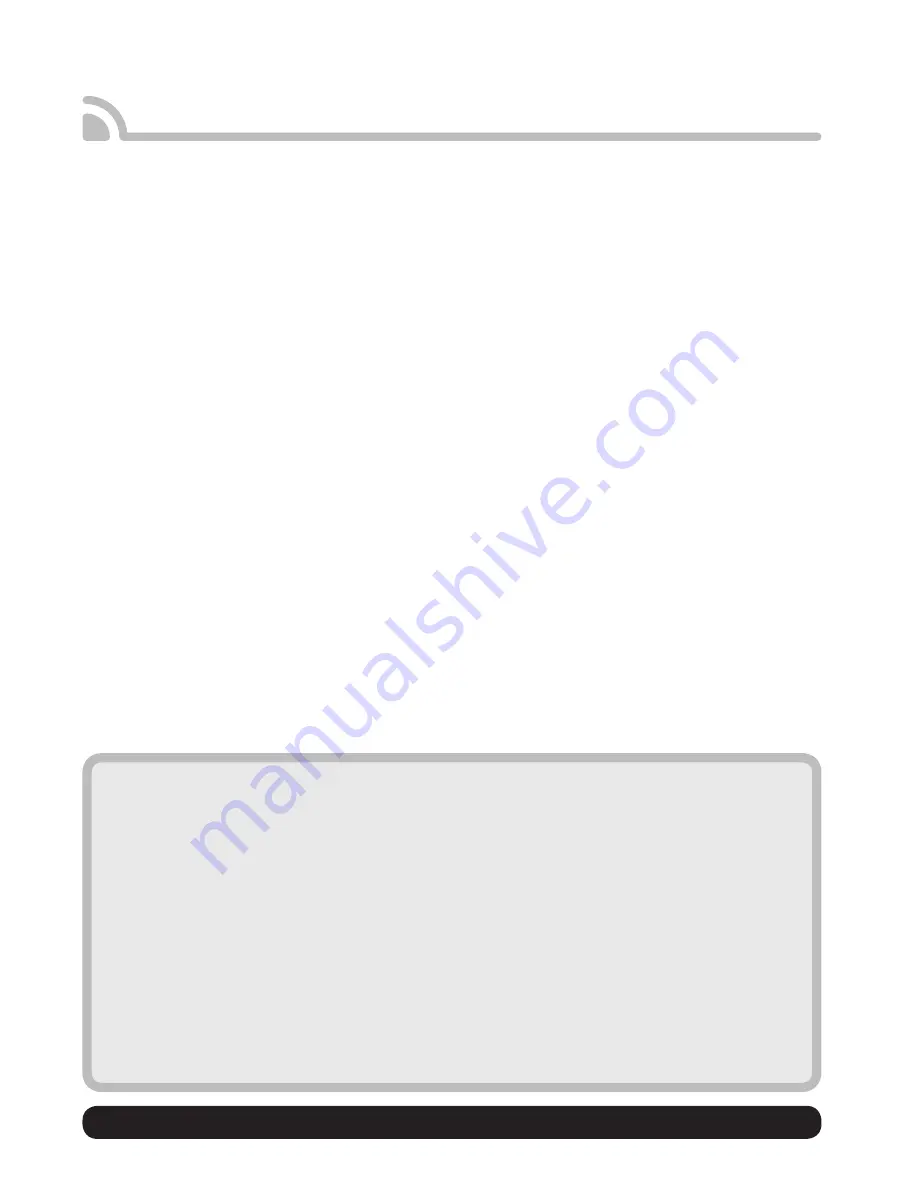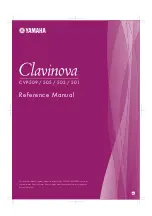
14
15
Pocket Miku’s functions are not limited to those operated by the buttons on the device. It is also possible to issue
MIDI commands from an external source to use the functions of the Yamaha NSX-1 sound chip that Pocket Miku
comes equipped with. Furthermore, it is possible to customize the functions of the buttons on the device itself.
Providing accompaniment for Pocket Miku using the GM sound generation
functions of the NSX-1
Yamaha’s sound chip NSX-1, which Pocket Miku is equipped with, allows users to utilize not just MIDI channel 1, but
also MIDI channels 2-16 (Pocket Miku uses MIDI channel 1) to produce GM sounds (128 tones and 1 drum kit). For
example, you can run musical accompaniment data on channels 2-16 with a MIDI sequencer while playing a melody
on your Pocket Miku, much like singing Karaoke.
Applying Pocket Miku’s built in effects
Pocket Miku’s built in Yamaha sound chip NSX-1 is equipped with reverb (29 types), chorus (24 types), insertion (181
types) and master EQ (5-band) effects. There are many ways to utilize these effects. For example, by using the pitch
changer, a component of the insertion effect, you can add harmonies to your sound.
* It is also possible to apply these effects to the GM sound generation.
* In order to correct the sound quality produced by Pocket Miku’s internal speakers, reverb and master EQ effects are
applied by default.
Customizing the buttons using “System Exclusive”
By using the specialized “System Exclusive” made for Pocket Miku, you can customize your device in a number of
ways, including the functions assigned to the buttons, the content of the preset lyrics, the start-up sound, and the
guiding voice and tone that is heard while operating the device. For example, you can assign internal effects to be
operated by pressing a previously unassigned combination of buttons simultaneously. You can also adjust the start-
up voice for a more natural sound.
For a more detailed user guide, please refer to http://otonanokagaku.net/nsx39/
Advanced users: GM sound generation, effects,
and customizing the buttons on your device
Types of MIDI data that Pocket Miku can send and receive
Only the 5 following types of MIDI data can be transmitted by the Pocket Miku (MIDI Channel 1/ eVocaloid
component) device itself. Additionally, there are some typical types of MIDI data that will not produce effects
when received by the device (* the GM sound generator component is an exception). For details, please refer
to the MIDI implementation chart on our website.
Types of MIDI data that can be transmitted by the main unit operation
: Key On (Note On/Note Off), Pitch
Bend Change, RPN 00 00 Pitch Bend Sensitivity, NSX-39 Specialized System Exclusive Data, etc. (Pressing the
Vibrato button on the main unit will not result in the transmission of CC 01 Modulation Data, but the device is
still able to receive CC 01 MIDI data.)
Types of MIDI data that will not allow effects when received
: 00 Bank Select MSB, 05 Portamento Time, 0A
Panpot, 20 Bank Select LSB, 41 Portamento, 42 Sostenuto, 43 Soft Pedal, 54 Portamento Control, 7C Omni Off,
7D Omni On, 7E Mono, 7F Poly, Program Change, Channel After Touch, Polyphonic After Touch, RPN 00 02
Coarse Tune, RPN 00 05 Modulation Sensitivity, etc.
These guidelines set out terms of use and cautions regarding your use of the
software, related printed materials, and digital files (hereafter, “the Software”)
provided by the Yamaha Corporation and Crypton Future Media, INC. (hereafter,
“the Companies”) included in the product you have purchased (hereafter, “the
Product”).
Please read through these guidelines before using the Product.
1. Copyright and Licensing
The Companies grant you a non-transferable license to use the programs and
data files that constitute the Software, as well as any corresponding upgrade
programs and data files that may be offered to you under certain conditions
(collectively, “Licensed Programs”). You shall hold the rights to the data that
can be produced through use of the Licensed Programs, but the Companies
and Yamaha’s licensors shall hold all rights related to the Licensed Programs,
including that of copyright.
2. Usage Restrictions
You are not permitted to perform the following actions through use of the
Software.
i. Publication or distribution of content featuring lyrics or other content that is
offensive to public order and morals
ii. Publication or distribution of content that defames, otherwise harms the
reputation of, or in other ways violates the rights of a third party
iii. Publication of content including any of the following without permission of
the Companies
1. Displays in products and services
If “VOCALOID(TM) (this includes descriptions of the same in the Japanese
language)”, Hatsune Miku or any items related to these (hereafter,
“Protected Displays”) are displayed in the following product or service-
related contexts:
a. Products and services with any kind of credit displayed, e.g. singer,
artist, or instrument names, which also show the Protected Displays
b. Products and services that use the Protected Displays in the
context of any kind of promotion or advertising such as packaging or
promotional materials
c. Products and services that use the Protected Displays in any form
recognizable by the consumer in contexts such as the opening or end
credits of video works
2. Use in commercial karaoke
Use in commercial karaoke software, karaoke hardware, karaoke systems
that use the Internet, and any other commercial karaoke product, in
addition to karaoke services (whether online, offline, or in any other form)
3. Commercial use in contexts such as ringtones for telephones or mobile
telephones
Commercial use in sounds such as call alerts or warning sounds for
telephones (including mobile telephones) or telephony devices
(hereafter, collectively “telephony devices”), not including the use of
musical ringtones that are sold exclusively as music to be used for
entertainment purposes
4. Embedding in devices or other such use as sound effects
In addition to the above, use as sound effects for commercial purposes in
home electronics, robots, arcade machines such as pachinko machines,
in-car devices such as car navigation devices, electronic instruments,
computer software including music creation software, computer terminal
applications such as smartphone or tablet apps, or in video game
software
5. Use in commercial video works
Use in commercial video works (not limited to animations, commercial
films, or video games) where people or characters appear to be singing
or performing
6. Use in commercial CDs and other such products produced by a
company
Use in CDs, records, cassette tapes, MiniDiscs, hard disks, flash memory,
IC memory cards, or any other storage media that has been produced
by companies for commercial purposes (hereafter, “commercial CDs and
other such products”), regardless of whether the recorded materials have
been produced by those companies or provided by a third party
3. Termination
The terms of use are in force from the day you obtained the Licensed Programs.
The license granted by the terms of use shall automatically terminate without
notification by the Companies should you violate copyright or any articles of
the terms of use. In this event, you must immediately cease use of the Licensed
Programs.
4. Disclaimer
You shall recognize and explicitly agree that you bear all liability for any risks
related to use of the Licensed Programs. The Licensed Programs and bundled
documentation are provided “as-is” without warranty. The Companies, whether
expressly, implied, or by law, make no warranties or representations relating to
the Software, including guarantees of quality, performance, non-infringement
of rights, merchantability, or fitness for any particular purpose. In particular, the
Companies make no warranties or representations that the Licensed Programs
are satisfactory to the user’s expectations; against interruptions or delays in the
Licensed Programs; for the safety, accuracy, or completeness of the Licensed
Programs; that the Licensed Programs are free of errors; or for corrections to any
faults or other shortcomings in the Licensed Programs.
5. Limitation of Liability
The Companies’ liability shall be limited to licensed items as specified in the
terms of use. The Companies shall not be liable for any damage caused by use
of or inability to use the Licensed Programs whether direct, consequential,
incidental, or indirect (including damage arising from data loss, loss of business
profits, business interruptions, or damage to business information), regardless
of whether damages incurred are ordinary or extraordinary in manner, and
regardless of whether the Companies have been informed in advance of the
possibility of such damage occurring or of damages being claimed by a third
party.
6. Use of Characters
When using the Software to create and publish representations that include
characters for which Crypton Future Media INC. holds the copyright and other
rights, please adhere to the Character Usage Guidelines (http://piapro.jp/license/
character_guideline) set out by Crypton Future Media INC.
7. Third-Party Software
In addition to the Licensed Programs, the Companies may provide third-party
programs, data files, and related documentation (hereafter, “Third-Party
Software”). Should Yamaha indicate that these are Third-Party Software, you
shall be bound by the contractual terms attached to the Third-Party Software,
and understand and agree that the provider of the Third-Party Software bears
all guarantees and other responsibilities with regards to that software. The
Companies do not bear any liability for Third-Party Software. The Companies
make no guarantees at all regarding the merchantability or suitability for any
particular purpose of the Third-Party Software, whether explicit or implied. You
must bear the liability for any risk arising as a result of the use or functionality
of Third-Party Software. The Companies will provide no customer support for
the Third-Party Software regarding instructions for use, faults, or other such
matters. The Companies shall not be liable for any damage caused by use of
or inability to use the Third-Party Software whether direct, consequential,
incidental, or indirect (including damage arising from data loss, loss of business
profits, business interruptions, or damage to business information), regardless
of whether damages incurred are ordinary or extraordinary in manner, and
regardless of whether the Companies have been informed in advance regarding
the occurrence of such damages.
8. General Terms
The laws of Japan (excluding principles related to conflict of laws) shall apply
to these terms of use, and it shall be understood that these terms are based
on Japanese law. In the event that any disagreements arise between you and
the Companies, both parties shall begin consultation in good faith; should
this fail, the Tokyo District Court shall have exclusive jurisdiction of the first
instance. Should part or all of any provision of this agreement be found to
be illegal, invalid, or not possible to execute by a court or administrative with
jurisdiction, or in the event that the affected provision (or part of the provision)
be determined not to conform with the fundamental characteristics of the
overall agreement, the legality, validity, or force of the remaining provisions
(including the remainder of the article including the affected provision) shall not
be affected. You shall represent and warrant that you are not resident in a state
subject to a United States embargo or listed on the United States Department of
Commerce list of Specially Designated Nations, and that you are not listed on a
United States Department of Commerce Table of Denial Orders. All legal notices
sent by you must be sent via mail in writing to the following address.
Semiconductor Division, Yamaha Corporation, 203 Matsunokijima, Iwata,
Shizuoka, 438- 0125, Japan
9. Acknowledgment
The conditions of this agreement constitute an entire agreement between
you and the Companies, and shall supersede all related prior agreements and
understandings. Any corrections or changes to the usage agreement are not
binding unless such corrections and changes are made in writing and signed by
the Companies.
10. Changes to the Guideline
The Companies may change the contents of this guideline. Once changes have
been made, the Companies shall inform the users of the changes and the items
changed, or announce the changes and the items changed on their websites.
Guidelines for Use of this Product

































